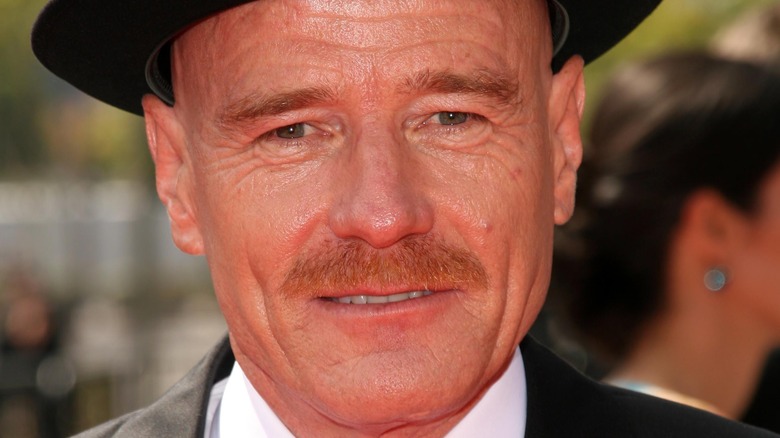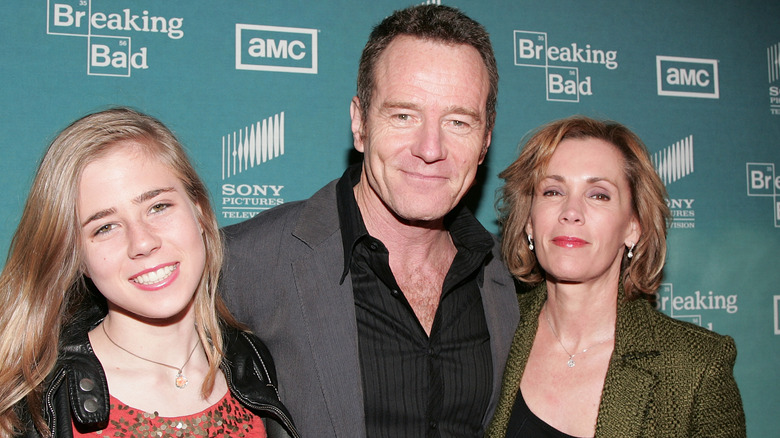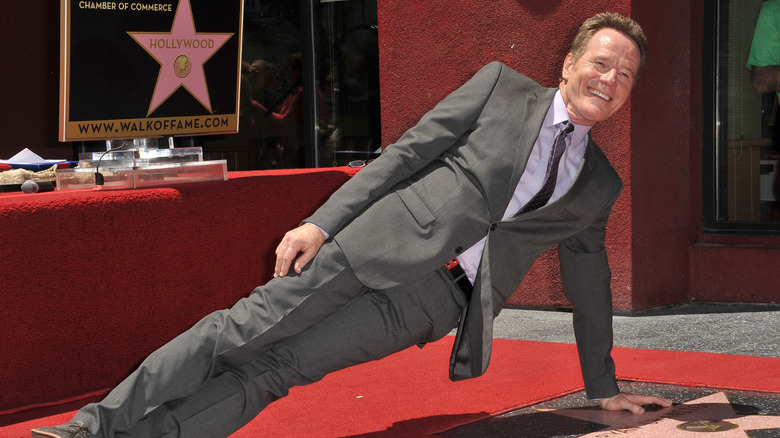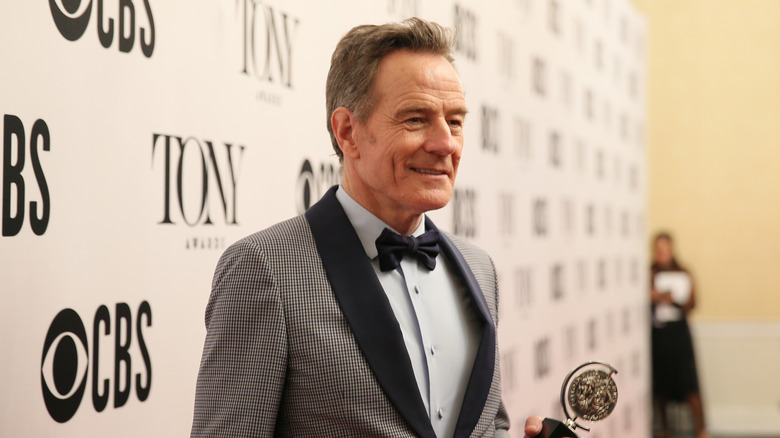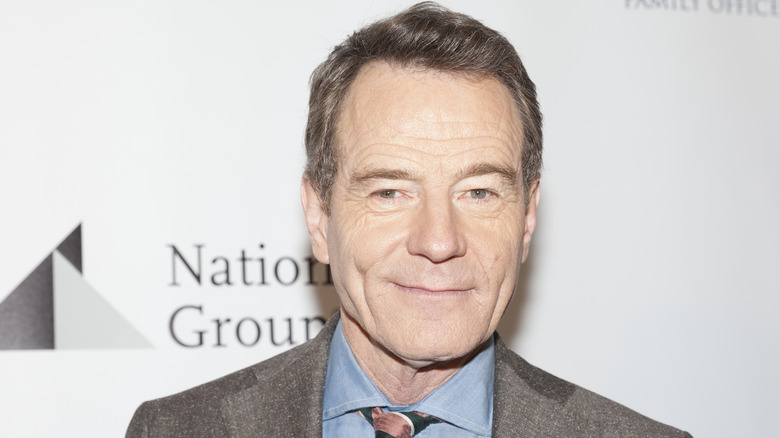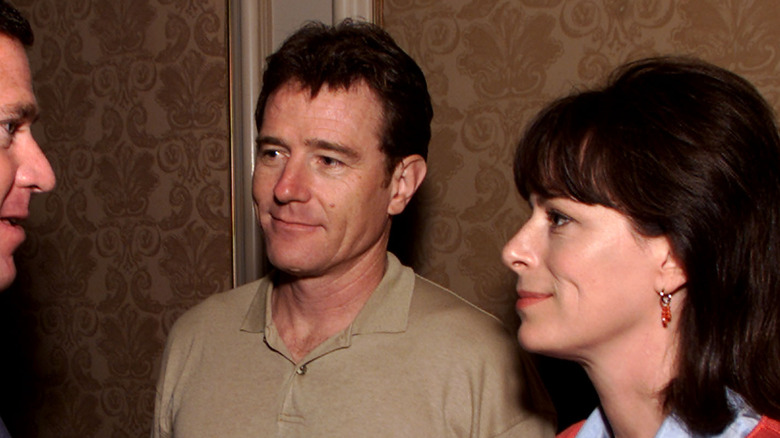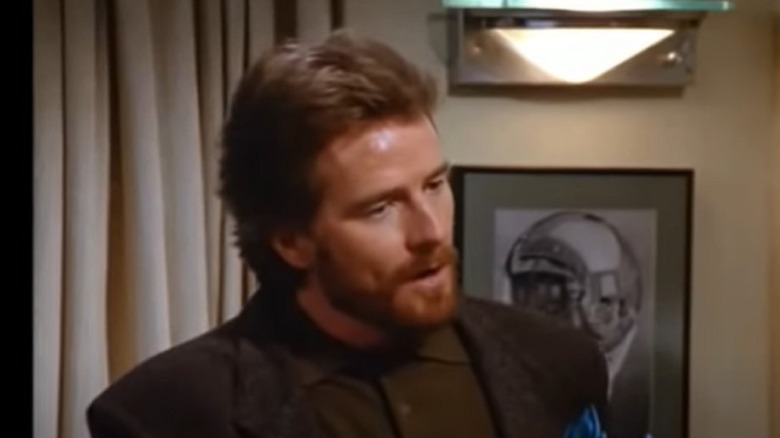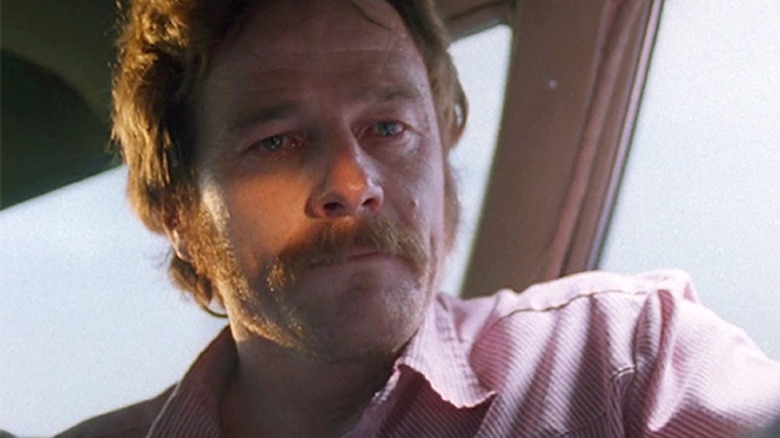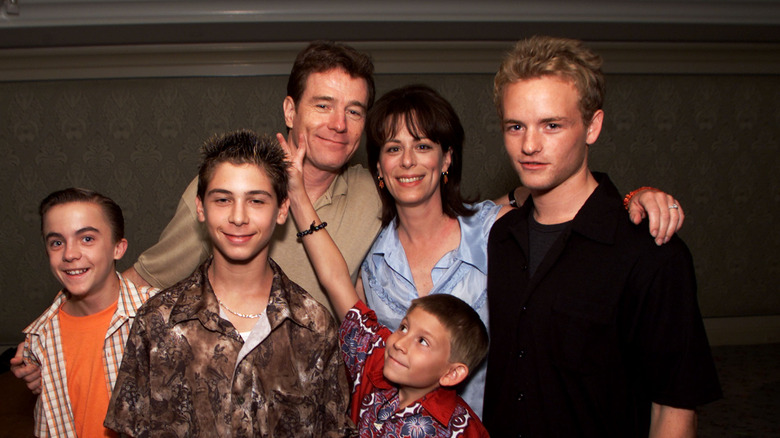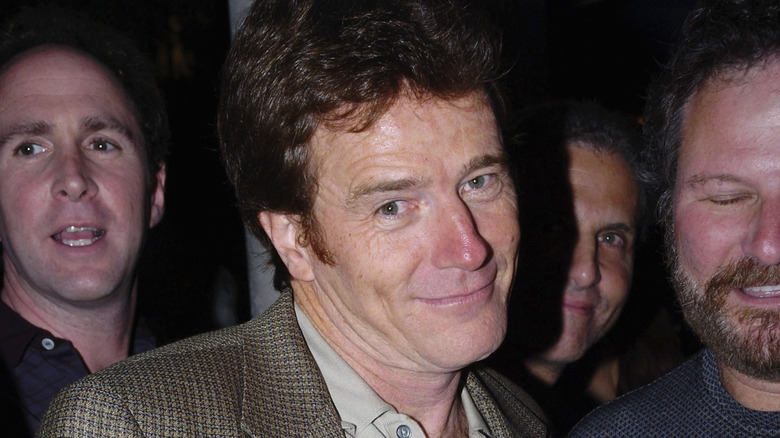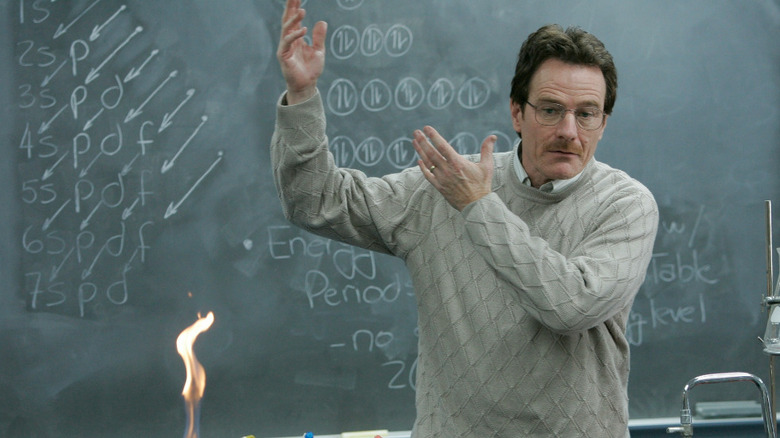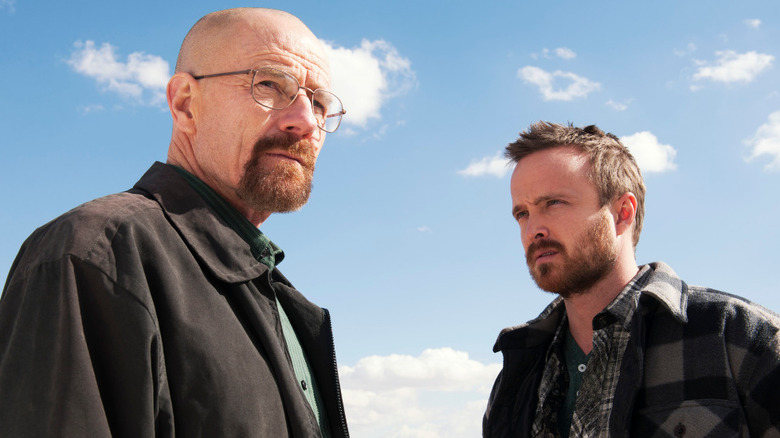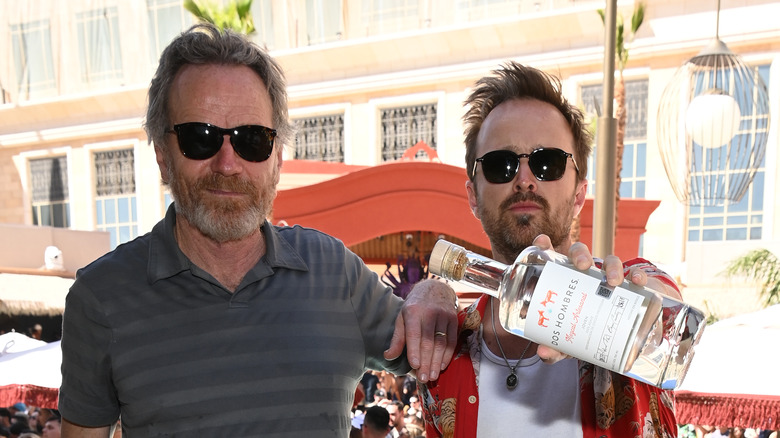The Transformation Of Bryan Cranston, From Childhood To Breaking Bad
When "Breaking Bad" hit the airwaves in 2008, it may have been a risky bet for its network, AMC. Thanks to stellar writing, beautiful cinematography, and the work of its actors, though, the show developed a vocal fan base and became a smashing success, earning four Emmy nominations for the first season — the start of many awards nods to come.
The show's popularity also propelled Bryan Cranston, who played protagonist Walter White, to A-list stardom. By the time he read the "Breaking Bad" pilot episode for the first time, he had been a working actor for decades. His determination to be a professional working actor led him to take roles in daytime soap operas and commercials alike. In addition to constantly working, Cranston was always learning. He took improv classes as well as acting classes in LA any chance he got. This experience made him a versatile actor, able to make audiences laugh as Hal in "Malcolm in the Middle" or loathe him in "The X-Files."
Here's how Cranston went from a determined working actor to the star of "Breaking Bad."
A Hollywood origin story
Born on March 7, 1956, in Hollywood, California, Bryan Cranston was one of three children. His mother, Peggy, and his father, Joe, met in an acting class in Hollywood. While his father landed smaller roles as an actor, he dreamed of becoming a star. Despite his ambition, he never achieved fame as an actor.
During Cranston's childhood, his parents' marriage deteriorated. Cranston and his older brother, Kim, escaped to the movies. When Cranston was 11, his parents divorced, and his dad left the family. Perhaps as a result of this, when Cranston began working as an actor, he didn't dream of fame. Instead, he would take any job available. He would reconnect with his dad over a decade later. His mother was left heartbroken by the divorce and without any income. Her drinking increased. The bank foreclosed on their house, and Cranston and his siblings had to live with their maternal grandparents in the San Bernardino Valley for the next year. They worked on the farm, collecting eggs and selling them to tourists.
A high school troublemaker
After Bryan Cranston moved back in with his mom in Canoga Park, he took odd jobs, like house painting and delivering papers, to help her with the mortgage. He was a self-professed troublemaker in high school, earning himself the nickname "Sneaky Pete." He snuck into group photos of different school clubs, including the newspaper and the chemistry club, without actually joining them.
After seeing his brother travel to locales like Japan and Hawaii with the LAPD Explorers, Cranston decided to join. He traveled across Europe on a month-long trip, visiting police stations in Germany, Switzerland, and Belgium. He took to police work, ultimately graduating first in his class. He developed a plan: he would go to junior college to study police science until he turned 21, when he could join the LAPD. He worked as a security guard at different locations across the city while he was in college. During one event, he crossed paths with Alfred Hitchcock.
A future cop
While at Valley Junior College, Bryan Cranston was told he needed to take a few electives to round out his transcript. Even after having a negative experience with acting in elementary school, he decided to take two acting electives. In his acting class, the ratio of women to men was higher and he was struck by how pretty the young women were. He was hooked.
But he now felt torn between being a police officer and being an actor. He knew how hard being an actor could be, but he was troubled at the thought of settling for a mediocre life as a cop. His brother was at a similar crossroads. Both of them decided to go on a road trip together. They packed up sleeping bags and a tent on their motorcycles and headed for the open road. Cranston brought along several plays to read, including Arthur Miller's "Death of a Salesman."
A jack of all trades
Bryan Cranston and his brother traveled across the country for the next two years. While they occasionally stayed in motels or homeless shelters, they slept outside most nights. When their cash ran low, they would need to take on work. As Cranston explained in an interview with Route magazine, "[A]nytime we saw a carnival on our trip – and when you are going in the summer and late fall or through the fall you do, you see carnivals setup — we would pull over because that was a guaranteed job."
When they returned to California, Cranston decided he was going to act. His first break came from a stroke of luck. (Cranston has always acknowledged the importance of luck in his transformation as an actor.) When he went to the Daytona Playhouse to ask about helping as a stagehand, the director instead handed him a script for "The King and I." Cranston would then go on to produce "Night of the Iguana" at the Playhouse.
A working actor
Bryan Cranston met Mickey Middleton while working at the Daytona Playhouse. When he decided to return to Los Angeles to pursue acting, she came along. They married soon after. However, the marriage was brief, ending in 1982; Cranston has written that he wasn't ready at that point in his life to be married.
Cranston worked non-stop, taking any part he could get. He would go on to do a Mars candy bar commercial (learning how to rock climb for the role), Preparation H commercials, even donning a skunk costume for Shield deodorant soap. In 1983, he landed a role on the soap opera "Loving" as Doug Donovan, a nice-guy professor, starring in episodes through 1984. He also landed roles on the show "Airwolf" playing Robert Hollis in 1986. In the episode, he attempts a kidnapping on a sorority reunion cruise. The role would be an important one; as he told People, he met Robin Dearden during that episode shoot. They would marry in 1989.
A saucy dentist on Seinfeld
In 1994, Cranston first played dentist Tim Whatley on the "Seinfeld" episode "The Mom and Pop Store." In the episode, George wants Whatley to take a look at a pencil believed to belong to Jon Voight and compare the bite marks to the ones on Kramer's arm.
Cranston would go on to star in five more episodes. When he returned to shoot "The Jimmy" in 1995, Cranston took a piece of comedic acting advice from the guy lighting the scene. "'It'd be funny if you first took a hit of the laughing gas before giving it to him,'" Cranston remembers him saying (via TV Guide). Both Seinfeld and Larry David loved it.
Cranston's character would have a brief relationship with Julia Louis Dreyfus' Elaine. The two alluded to the on-screen romance at The Emmys in 2014. Dreyfus pretended not to remember Cranston. When she won the Emmy for her role on "Veep," they kissed in the aisle.
A scary, humane villain on The X-Files
Before Vince Gilligan created "Breaking Bad," he worked as a writer, director, and executive producer for the show "The X-Files." Inspired by the movie "Speed," he came up with an episode idea where a man's head will explode if his car drops below a certain speed. That episode idea turned into the season six episode "Drive." In the episode, Cranston played Patrick Crump, a bigot who takes Mulder hostage and has to keep driving west to stay alive. Gilligan told New York Magazine wanted Crump to be played by someone who "could be scary and kind of loathsome but at the same time had a deep, resounding humanity."
Gilligan would remember Cranston's performance nearly 10 years later when casting for Walter White. But AMC executives were skeptical; could this goofy dad really play a scary drug dealer? Gilligan used "The X-Files" episode to convince AMC executives that Cranston was the right choice.
A lovable goof on Malcolm in the Middle
While many viewers know Bryan Cranston as the dramatic Walter White, he was cast in "Breaking Bad" after wrapping "Malcolm in the Middle," where he played Hal, the goofy, immature father. The show, which ran from 2000 to 2006, broke the mold in many ways: it used a single camera, did away with the laugh track, and followed a working-class family trying to make ends meet. As Hal, Cranston would take part in all sorts of on-screen hijinks, including wearing a coat of live bees.
After the show ended in 2006, there was a possibility that "Malcolm" would come back for another season. Cranston was excited at the prospect. But, he explained (via NME), the Fox executives called and said, "'Nope, we had a very good pilot season. Thank you guys, you did well. You're on your own.' So we thought, 'Ahh, that's too bad.'" Had he done another season, he wouldn't have been available to shoot the pilot for "Breaking Bad."
An unlikely drug dealer
After "Malcolm in the Middle" ended, Bryan Cranston was looking at roles that let him step away from the goofy dad type. He auditioned for "Pineapple Express," a 2008 stoner comedy, likely for the role of Gary Cole, a vicious drug dealer. Director Judd Apatow revealed on Twitter that while Cranston auditioned for the role, he "didn't seem scary enough to be a drug dealer." Apatow also reflected that, had Cranston been cast, he might not have gotten "Breaking Bad" because he would have been typecast.
While Vince Gilligan wanted Cranston to play Walter White, the show auditioned several other actors including Matthew Broderick and Steve Zahn. Cranston was taken with the character of Walter White and the pilot script. This type of character transformation, going from "Mr. Chips to Scarface" was new for TV at the time. But thanks to a stroke of luck (and perhaps a fake news tip he added to the papers) Cranston landed the role without having to audition.
Antihero Walter White
Bryan Cranston drew from several moments in his life when shooting "Breaking Bad." In the pilot episode, Walter White is downtrodden, seemingly weighed down by the world. As he explained on "The Howard Stern Show," Cranston was inspired by his own father's disappointment and brought that to the role. Baggy clothes in neutral colors and a mustache that critics have described as "a dead caterpillar" completed the look. Cranston played White as a pathetic man who, when he receives his cancer diagnosis, finally starts living life on his own terms.
Cranston also drew from his experience in his early 20s later in the series. When Walter's hesitation leads to the death of Jesse's (Aaron Paul) girlfriend, Jane (Krysten Ritter), Cranston thought back to that relationship when he dated a woman who later threatened him, stalked him, and overdosed on drugs. Because of that relationship, he said (via The Daily Beast), he understood how someone could be backed into a corner to kill another person.
Breaking Bad
A writer's strike cut the first season of "Breaking Bad" short. Despite having just seven episodes, the show received positive reviews. This would be another hit for the network AMC, having recently debuted the 1960s drama "Mad Men" the previous year. (The network would have another hit on their hands in just a few years with "The Walking Dead.") By the time the series finale aired, 10 million people tuned in (via Recode), up from 2 million for the finale two years before. Gilligan believes this was due to Netflix carrying the show on its streaming platform.
As the show progressed, viewers watched as Walter slowly descended further into becoming an antagonist. Cranston credits the show's slow progression with keeping the audience on Walter's side; it left the audience grappling with the moral ambiguity of its characters. Even when Walter does unspeakable things, Cranston wrote in "A Life in Parts," the audience still roots for him.
Lifelong friends
"Breaking Bad" came to its conclusion in 2013. In an interview with The Hollywood Reporter, Cranston called the series finale "the perfect ending."
"I know I'm biased, but I don't recall seeing the ending of a show that was so well-constructed, satisfying and legitimate," Cranston said. "Everything just seemed to fall into place so extraordinarily well." He briefly resurrected the role of the transformed Walter White for the Netflix movie "El Camino: A Breaking Bad Movie," which follows Jesse Pinkman after the final episode.
On set, Cranston and Paul developed a strong friendship. Paul has said that Cranston took on the role of a mentor to him. Years after "Breaking Bad" finished, Paul had the idea of creating a mezcal. In 2019, the two launched a mezcal together called Dos Hombres. It has since been named "New York Blanco Mezcal of the Year" and the winner of the London Spirits Competition (via Rolling Stone).
